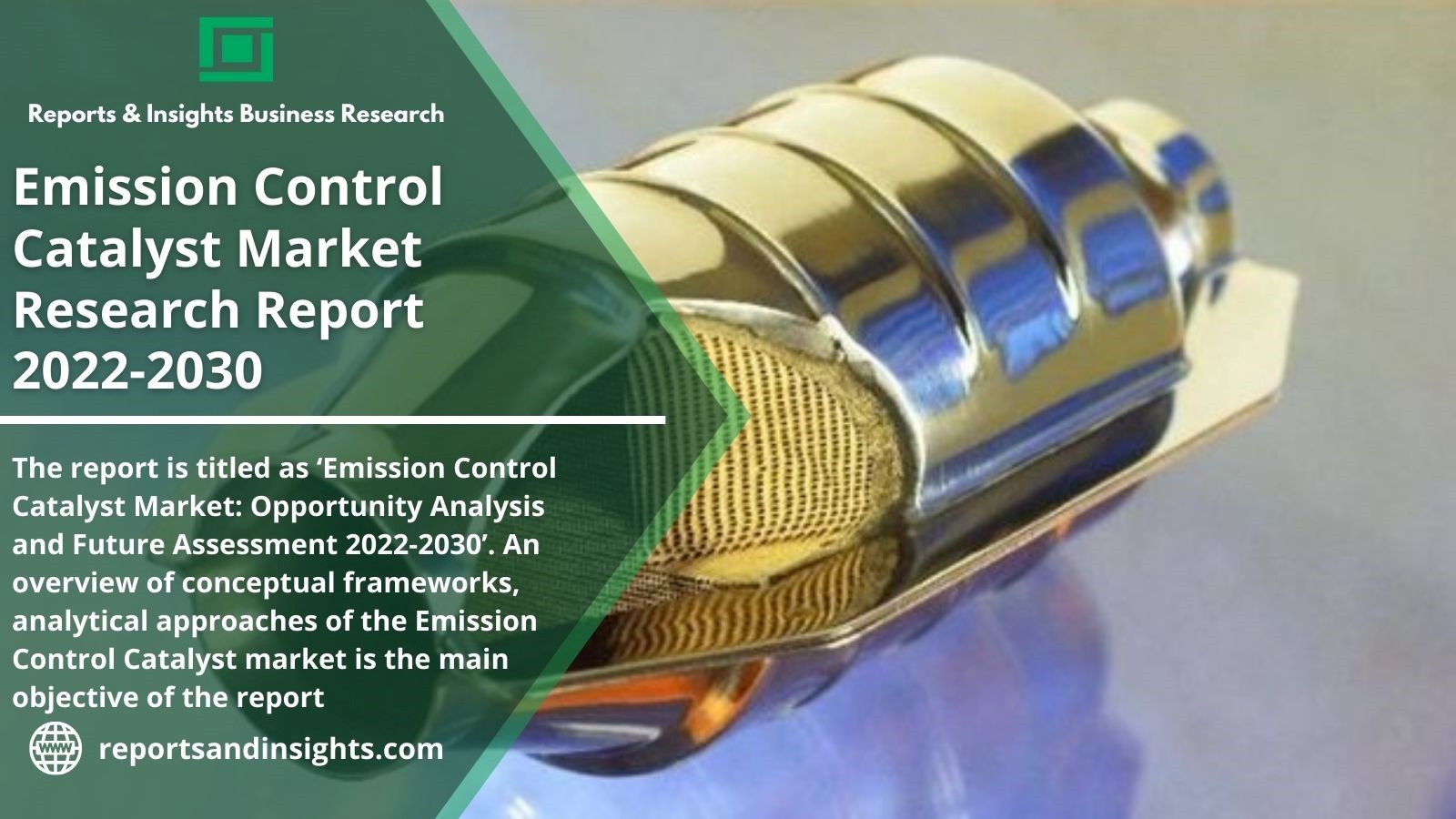Automotive
Emission Control Catalyst Market Size to Reach US$ 41,475.6 Million in 2030 Growing at a CAGR of 5.2%, According to Research by Reports and Insights…

Reports and Insights issued a report recently titled “Emission Control Catalyst Market: Opportunity Analysis and Future Assessment 2022-2030”
The emission control catalyst market is estimated to reach at a value of US$ 27,665.2 Mn by the end of 2022 and expected to reach at a value of US$ 41,475.6 Mn by 2030 with a significant CAGR of 5.2%.
Request To Download Sample of This Emission Control Catalyst Market Report:
Many times, gases and production by-products released by internal combustion engines and industrial exhaust contain compounds that are recognized to be bad for the environment. Catalytic converters employ emission control catalysts to cut down on these damaging emissions to the environment. These catalysts are designed in catalytic converters based on fuel type including diesel and gasoline. Several types of catalyst are used for various applications.
In current generation diesel-powered vehicles and equipment, Selective Catalytic Reduction (SCR), an advanced active emissions control technology system, decreases tailpipe emissions of nitrogen oxides (NOx) to almost zero levels.
Key Takeaways from the study
- The emission control catalyst market is expected to increase 1.5X times during the forecast period
- Diesel based emission catalyst segment is expected to be a prominent product type, and expected to create an incremental opportunity of US$ 11,678.5 Mn during the forecast period
- Mobile equipment segment is anticipated to a prominent application segment as compare to its counterparts
- Selective catalytic reduction segment is anticipated to create significant market opportunities for the key players in the coming years
- Asia Pacific region is expected to account for a prominent market share in the global business of emission control catalyst owing to substantial base of the end users
Emission Control Catalyst Market Driver: Substantial volume production of vehicles is enhancing the sales of autocatalyst
The global automobile sector is predicted to experience consistent development in terms of demand and sales despite the shaky economic environment, supported by substantial sales of vehicles with diesel and gasoline engines. The market for pollution control catalysts will benefit from this. The growth of the automobile industry in developing nations can be related to the acceptance of lighter cars. The demand for passenger vehicles will also continue to rise in emerging nations like India, China, Brazil, and others, expanding the potential for rising automotive output. Manufacturers of pollution control catalysts will have even more attractive chances owing to increasing sales, which are being driven by the expanding population and increased disposable income.
In addition, the introduction of strict government restrictions would increase demand for equipment like automotive telematics, emission control catalysts, and other tools used to reduce vehicle emissions. With China and India accounting for a key market share, Asia Pacific has emerged as a lucrative region for numerous international market players operating in the market. Relatively lower operating expenses, the area provides simple access to raw materials. As a result, a number of key businesses are signing long-term supply contracts with local suppliers in order to gain a competitive edge in the market.
Emission Control Catalyst Market Competitive Landscape
Key participating players of emission control catalyst are BASF SE, Johnson Matthey, W.R. Grace, Sinocat Environmental Technologies, Cormetech, Solvay S.A., Faurecia, Haldor Topsoe, Clean Diesel Technologies, Tenneco, Umicore SA and many others. In 2021, BASF holds the largest market share around the globe and is expected to maintain its dominance in the upcoming years.
Emission Control Catalyst Market Segmentation
The emission control catalyst market is segmented on the basis of product type, application, catalytic converter type, pollutant type, end use, and region
By Product Type:
Diesel Based Emission Catalyst
Diesel Oxidation Catalyst (DOC)
Selective Catalytic Reduction Catalyst (SCR)
Catalysed Soot Filter/ Diesel Particulate Filter
Ammonia Oxidation Catalyst (AMX)
NOx Adsorbers
Gasoline Based Emission Catalyst
Palladium based catalyst
Rhodium based catalyst
Platinum based catalyst
By Application:
Mobile Equipment
Heavy-Duty Vehicles
Off-Road Vehicles
Passenger Cars & Light Duty Vehicles
Motorcycles, Scooters and Three Wheelers
Gardening Equipment
Stationary Equipment
Industrial Engines
Generators
Off-Road Equipment
By Pollutant Type:
Nox
CO
Hydrocarbons or Volatile Organic Compounds – (HC/VOC)
HAPs
DPM (Diesel Particulate Matter)
NH3 (Ammonia)
By Catalytic Converter Type:
Diesel Oxidation Catalyst
Selective Catalytic Reduction
Lean Nox Trap
Three-Way Catalytic Converter
Four-Way Catalytic Converter
By End Use:
OEM
Retrofit
By Region:
North America
Latin America
Europe
Asia Pacific
Middle East
Africa
-

 Home and Garden5 days ago
Home and Garden5 days agoTransform Your Space: A Guide to Minimalist House Interior Design in 2025
-

 Home & Family6 days ago
Home & Family6 days ago10 Essential Cleaning Hacks for Bathroom Surfaces You Need to Try
-

 Health & Fitness6 days ago
Health & Fitness6 days agoDiscovering the Best Multivitamin for Women Over 40: Essential Nutrients for Optimal Health
-

 Health & Fitness5 days ago
Health & Fitness5 days agoDiscover the Best Multivitamin for Women Over 40: A Comprehensive Guide to Optimal Health
-

 Automotive5 days ago
Automotive5 days agoUnlocking Performance: Why the HP Spectre x360 is the Ultimate 2-in-1 Laptop for 2025
-

 Crime6 days ago
Crime6 days agoExploring the Most Anticipated New True Crime Documentaries of 2025
-

 Business6 days ago
Business6 days agoMaximize Your Earnings with American Express High Yield Savings Accounts in 2025
-

 Artificial Intelligence6 days ago
Artificial Intelligence6 days agoBreaking Generative AI News: Innovations Shaping the Future of Technology


















